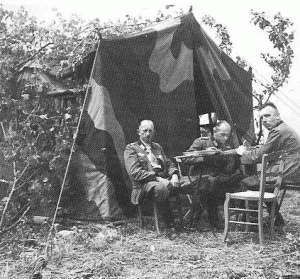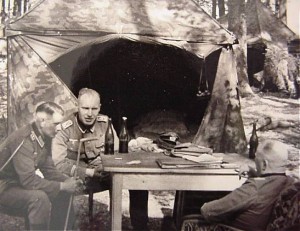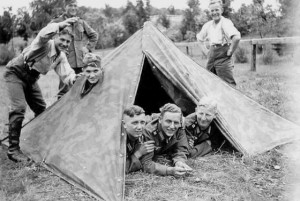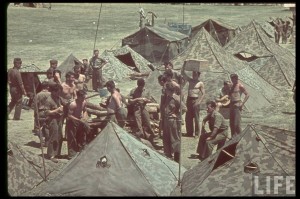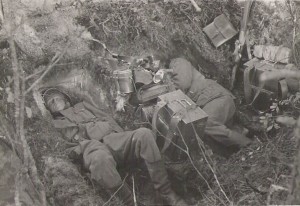Encampment
Reenacting the life of the WWII German Soldier doesn’t stop at the end of the battle day. We continue to keep an accurate impression while encamped or in barracks.
Where we stay and how we stay there will greatly depend on scenario, availability of resources, and realistic concessions to weather.
In the field.
Depending on the scenario, how we stay in the field will vary greatly.
Ideally we want you to have everything on your back and walk away from your car for the duration of the event. No modern tents are allowed, and we discourage the use of modern camping gear of any kind. Everything you need for the weekend should fit in your pack.
There are plenty of resources on what to pack and how elsewhere, suffice to say as you should be conscious of how you are packed well before the event to help facilitate this.
Staff Tents
Staff tents are for officers and certain specialty positions like medics and communications. They are purchased by and maintained by their owner, they are not a free-for-all crash space. Tents are inefficient in a modern mobilized army, and should only be used to protect and maintain equipment. An officer’s tent may be where he sleeps, but it’s also where maps, tactical information, and important communications are stored. A communications staff also uses their tent to protect radios, field phones, and other sensitive equipment. The same goes for medical staff.
The “Stabszelt” is typically an 8’ x 8’ tent used by a single officer and his equipment. The “Truppenzelt” is a larger tent and can be three times the size as the “Stabszelt”. It would typically be used for recovering injured, or in cases where a team doing paperwork or working radios would need cover from the elements.
In some cases, staff tents could be made using several zeltbahn shelter quarters.
Shelter Quarter Tents
The Shelter quarter or Zeltbahn was first issued in 1934, and was made so two tents could be made per squad in foul weather. Four men could sleep in the tent, wrapped in blankets with their heads on their packs. With six men, a tent can be made with ground cover, (four sleep, two keep watch in shifts). With 8 and 12 men, larger patterns of the tent can be made, but the number that can comfortably sleep inside it doesn’t improve radically. Typically larger versions of the tent were reserved for protecting gear, supplies or heavy weapon positions.
If given the orders to make camp, and the commander allows it, men can make zelt tents to sleep in. they may be asked to give up their shelter quarter for company purposes in some circumstances.
Blankets, greatcoats, and zelt as a ground cover.
In MOST circumstances, a tent will not be made and the zeltbahn will be used as ground cover. Lay it on the ground and use a wool blanket for warmth. If you have a greatcoat, it can be used as additional cover. Use your full pack as a head rest.
This allows for faster mobility from position to position, and prevents making large markers visible from the air.
